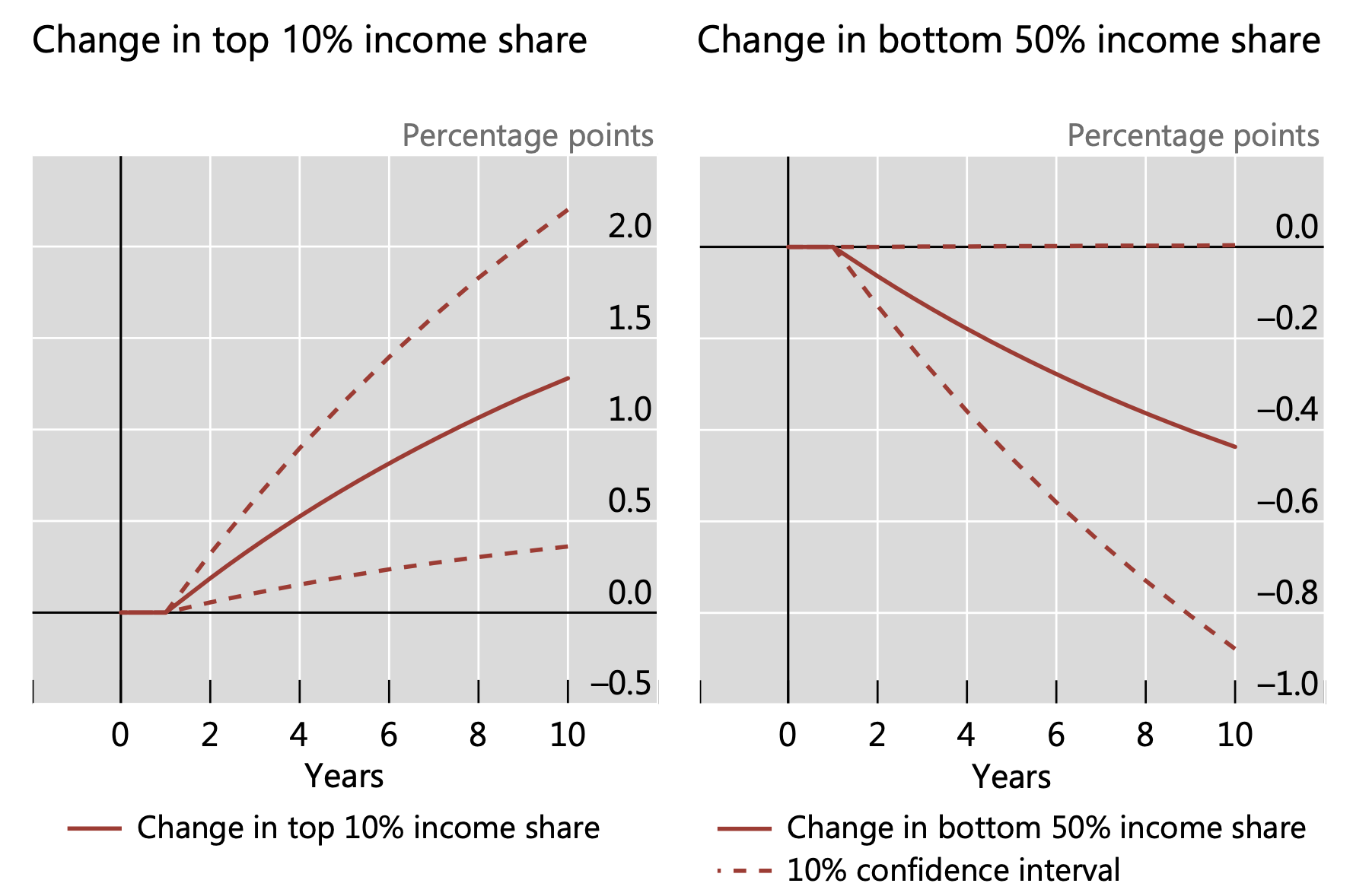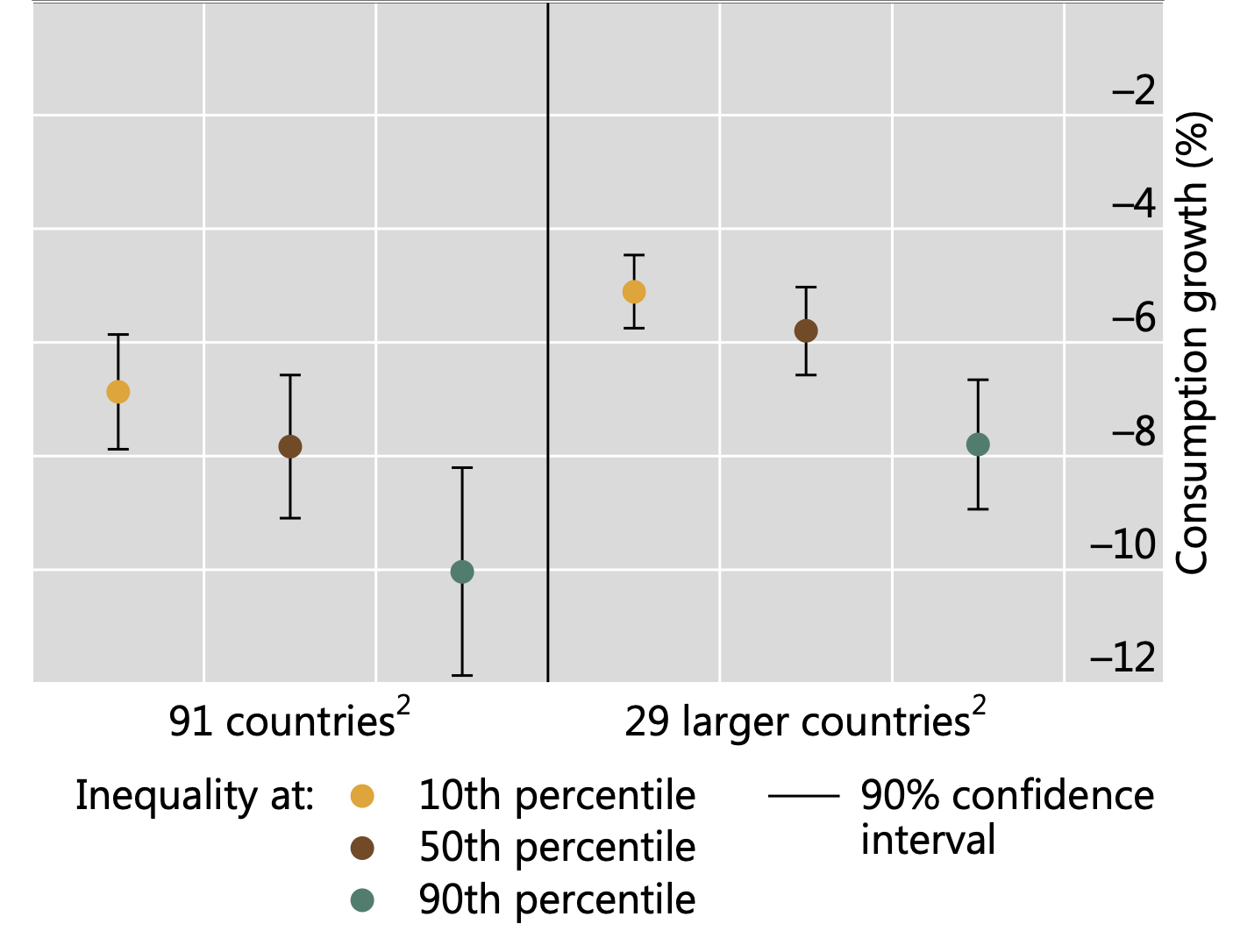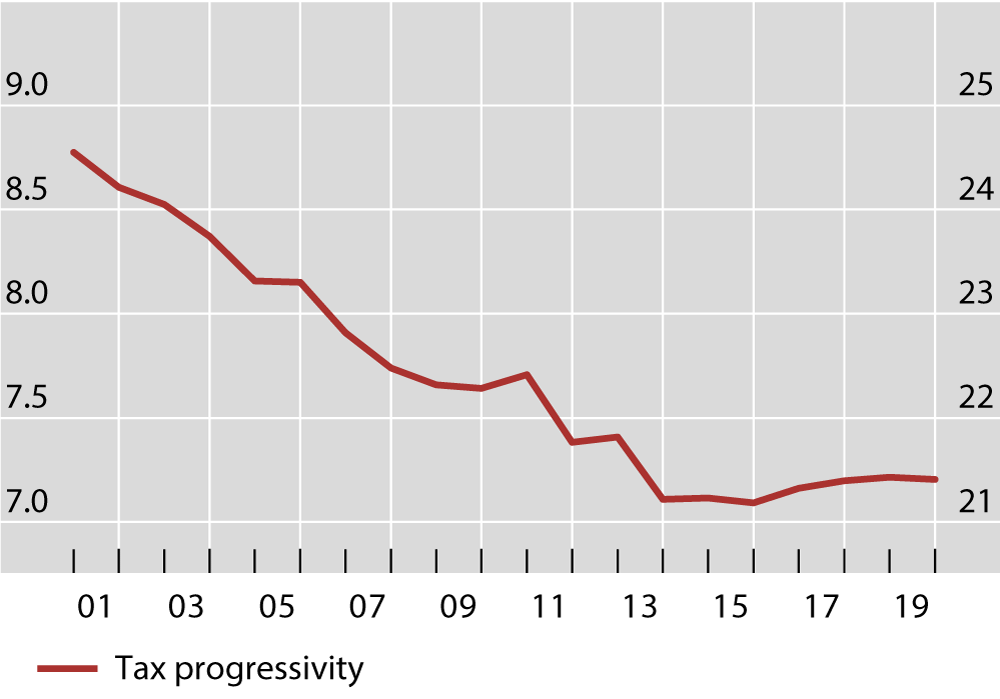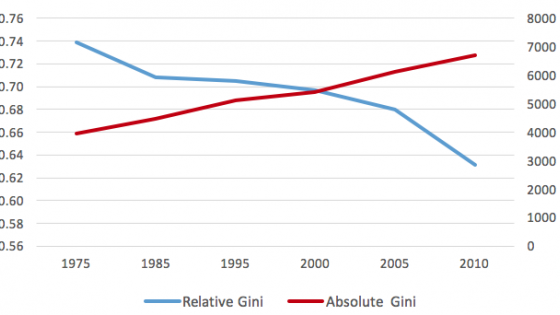Economic inequality has been on the rise since the 1980s in most economies (see, for example, Niño-Zarazúa et al. 2016). Yet, the issue of growing inequality has only gained prominence in the public debate over the past decade, as the Global Crisis and then the Covid-19 recession exacerbated slow-moving trends towards higher inequality. Drivers of such long-run upward trends have been widely investigated and discussed in the academic literature as well as in policy circles: On the one hand, globalisation and technological change, which tend to have disproportionate side effects on low-skilled and low-wage workers, have often been singled out as major contributors to inequality (Dorn and Levell 2022). On the other hand, many advanced economies (AEs) have experienced a shift away from redistributive policies over the last decades (see Piketty et al. (2018) for evidence on the US) that has likely contributed to unleash forces pushing inequality up.
On top of these long-run trends, economic inequality has an important cyclical dimension (Blanchet et al. 2022). Economic downturns are a striking example of periods of accelerating inequality, in part because adverse shocks hit first and foremost low-skilled and low-wage workers, who lose their jobs first – and are usually last to find a new one. Yet, until recently, the prevailing view has been that fluctuations in inequality tend to wash out over the business cycle, i.e. that increases in inequality during recessions tend to be compensated by corresponding decreases during expansions.
In our recent monograph, entitled “Inequality Hysteresis”, we argue that empirical evidence does not support this benign view that fluctuations in inequality wash out over the business cycle (Pereira da Silva et al. 2022). Rather, the data suggest that surges in inequality following recessions tend to persist for a long time, a phenomenon we label as ‘inequality hysteresis’. Our findings therefore suggest that hysteresis compounds and exacerbates the rising trend in inequality due to long-run structural changes. Moreover, from a policy perspective, counter-cyclical macroeconomic policy, and in particular, policy support aimed at reducing the length and depth of recessions, can have strong implications for inequality, by cutting short business cycle phases where inequality steps up.
Movements in and out of employment are a key driver of inequality, at least in the short run (see, for example, Lenza and Slacalek 2018) as labour income makes for the bulk of households’ income, especially for those at the bottom of the income distribution. A simple mechanism for inequality hysteresis could therefore be as follows: when an economic downturn sets in, these low-skilled, low-wage workers are typically the first to be laid off. Moreover, in the recovery phase when new jobs become available, skill obsolescence and the lack of re-training possibilities imply that finding new opportunities may take these workers longer and imply significant pay cuts. Meanwhile, those who were able to keep their jobs – typically higher up in the income distribution, gain ground in relative, if not in absolute terms.
Changes in the income share of the top 10% and bottom 50% earners following recessions are good examples of the lingering effect of recessions on inequality. Based on the experience of 91 countries, covering a total of 247 recessions –defined as periods of negative yearly GDP growth – the evidence shows that the top 10% earners experience a significant increase in their income share in the aftermath of a recession (Figure 1, Panel A), while those at the bottom 50% of the income distribution experience a drop in their income share (Panel B).
This pattern of diverging income shares between the top and the bottom is even more prevalent in countries where job security is weaker (see Chapter 2 in Pereira da Silva et al. 2022). In such countries, workers are indeed less protected against layoffs during recessions, leading to larger increases in inequality.
Figure 1 Inequality is persistently higher after recessions (in percentage points)
Source: Pereira et al. (2022).
In addition to recessions worsening inequality, higher inequality also tends to make recessions deeper. This is a key reinforcing factor that contributes to hysteresis and makes it more severe over time. While many factors could account for why recessions tend to be deeper in more unequal societies, differences in marginal propensities to consume between high and low-income households likely play a significant role. When a recession hits, those at the bottom of the income distribution lose their jobs in larger numbers. As a result, the share of income that goes to richer households mechanically increases, implying that a larger share of aggregate income flows to those that consume less. Overall, this shift contributes to further reducing aggregate consumption and deepening output losses. Empirically, countries that enter a recession while being more unequal typically experience a larger drop in consumption (Figure 2, left-hand panel). Interestingly, this pattern holds for both advanced economies (AEs) and emerging market economies (EMEs), even if the difference in consumption shortfalls between low and high inequality advanced economies tends to be somewhat smaller than for emerging market economies (right-hand panel).
Figure 2 During recessions, consumption falls more in countries with higher degrees of income inequality
Source: Pereira et al. (2022).
Against this background of mutually reinforcing effects between inequality and recessions, we also tested whether macroeconomic policies are impacted by inequality. We first provide evidence that monetary policy is less effective in stimulating the economy when inequality is high. To the extent that monetary policy affects the real economy by stimulating consumption, situations where income is very polarised can severely limit this mechanism. Once again, differences in marginal propensities to consume could be key. In particular, consumption for households of the upper end of the income distribution may respond less to financial conditions than for households at the low end. Consequently, whenever the rich account for a larger income share, monetary policy becomes less effective in stimulating consumption and the economy as a whole.
The finding has direct implications for fiscal policy. Insofar as monetary policy is less effective when inequality is higher, this means that fiscal policy must take a larger share of the macroeconomic stabilisation burden. Taxes and transfers are, in this regard, a powerful and straightforward instrument, whose appropriate calibration can help to address inequality, for instance through the level and progressivity of taxes. This stands in sharp contrast to monetary policy, which notwithstanding its distributional consequences, remains a very blunt instrument (Bank for International Settlements 2021).
Obviously, the design of the tax system matters for income inequality. After-tax inequality is much more limited than before-tax inequality. What is less known however is that features of the tax system, beyond their correction of before-tax income inequality, also influence the dynamics of the business cycle. For instance, higher progressivity of income taxes makes fiscal policy more counter-cyclical. One reason is that governments run larger surpluses in expansions that are periods when government revenues increase more than income. Symmetrically, deficits tend to be larger in recessions when government revenues fall more quickly than incomes. Yet, tax progressivity has been steadily declining over the last two decades in advanced economies (Figure 3), and unemployment benefits have followed a similar trend.
Figure 3 Cross-country average income tax progressivity close to historical lows (in per cent)
Source: Pereira et al. (2022).
Taken together, these different pieces speak for rehabilitating fiscal policy as a highly effective stabilisation policy. Fiscal tools that can be deployed with clear, deliberate, and powerful mandates to reduce income inequality would also benefit society in stabilising the business cycle. This will help mitigate hysteresis that compounds inequality trends. It will also shield central banks and their independence, reducing the risk they inadvertently find themselves trapped as the ‘only game in town’ during future recessions.
References
Bank for International Settlements (2021), “The distributional footprint of monetary policy”, Chapter II, Annual Economic Report.
Blanchet, T, E Saez and G Zucman (2022), “Real-time inequality”, NBER Working Paper 30229.
Dorn, D and P Levell (2022), “Changing views on trade’s impact on inequality in wealthy countries”, VoxEU.org, 14 February.
Kohlscheen, E, M Lombardi and E Zakrajsek (2021), “Income inequality and the depth of economic downturns”, Economics Letters 205, 109934.
Lenza, M and J Slacalek (2018), “How does monetary policy affect income and wealth inequality?”, ECB Working Papers, no 2190.
Niño-Zarazúa, M, L Roope and F Tarp (2016), “Income inequality in a globalising world”, VoxEU.org, 20 September.
Pereira da Silva, L A, E Kharroubi, E Kohlscheen, M J Lombardi and B Mojon (2022), “Inequality hysteresis”, BIS manuscript, 19 May.
Piketty, T, E Saez and G Zucman (2018), “Distributional National Accounts: Methods and Estimates for the United States”, Quarterly Journal of Economics 133: 553-609.











